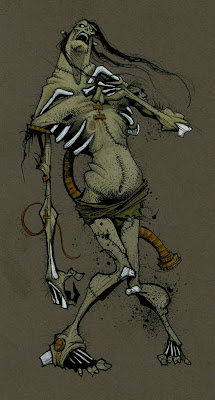The Stephen Asma article intrigued me further as he writes, "the uses of monsters vary widely. In our liberal culture, we dramatize the rage of the monstrous creature—and Frankenstein's is a good example—then scold ourselves and our 'intolerant society' for alienating the outcast in the first place. The liberal lesson of monsters is one of tolerance: We must overcome our innate scapegoating, our xenophobic tendencies." (Asma). Again, I personally feel all the characters of Grimly's text have an "other' aspect to them. With all characters resembling something other than what we would typically assign as "human" our mind does not automatically cast the creature as something to be feared due to it's unfamiliar nature. At this point in the text, I have sympathy for the creature and very little for Victor. Combining the ideas of the McCloud theory from last week, I believe Grimly's remix of Shelly's story into a graphic text with visuals makes the overall work more impactful. The reader is challenged to question early on if the creature is, in fact, a "monster."

This is a really good point I didnt really think about. When reading the original novel, I just imagined all of the human characters are boringly normal! But. in this novel, they are depicted in kind of a 'tim burton' eccentric way, which totally blurs the lines between monster and human, considering the main reason people are scared is because he is so hideous.
ReplyDeleteAbbey, thank you for vocalizing an aspect of the visuals I failed to do--the idea of what is socially normalized as attractive or unattractive. I was certainly thinking how everyone looked like a monster so personally I found it easier, but I never thought of how the character's may have viewed the monster, silly as it may sound. It's an important point to remember that so much of how we view people is built first on our perception of their physical appearance and we have a more positive reaction to what is classically attractive.
DeleteI really like the idea about challenging the reader. I have to admit I definitely did not think of this text in that way. I certainly was taken a back by the monstrous resemblance of every character in the book and early on I definitely wondered why Grimly choose to do this. Your phrasing of blurring those lines definitely does allow me to dislike Victor more and sympathize with the monster. That probably would have been a bit different with different artwork, but I think it speaks to the deliberate choices of the producers of this text. Personally I think its clear they want us to empathize for the monster by many of the choices they made throughout the first 100 pages of the book.
ReplyDeleteI think it's hard for all of us who immediately picture Boris Karloff's monster (https://images-na.ssl-images-amazon.com/images/I/61ZgVkm6e4L._AC_SY741_.jpg) to see anything else when we read Shelley's text. The triumph of Grimly's version to me is that it utterly displaces that familiar Karloff face and allows me to focus on what is on the page in front of me.
ReplyDeleteDr. MB-- it's funny I haven't once thought of the stereotypical image of the creature while reading this text. I'm not exactly sure why that is though. I am obviously familiar with the image you draw our attention to even though I have not read Shelly's original text. I would like to believe it's because I am so focused on Grimly's illustrations, but it might just be cabin fever getting to me.
DeleteWhen I saw Grimly's version of the creature especially from the one shown above, it almost seemed to be a grotesque version of Jesus on the cross.
DeleteI definitely agree with you in that Grimly's illustrations aid in "blurring the lines" between who is human and who is really a monster. I have to say, in the beginning when the creation is first introduced, I definitely saw him as a monster. I'm thinking that I probably just saw him that way, though, because we were being led to view it from Victor's perspective. It really wasn't until the end of our reading when the creature is hiding in the little farmhouse that I really started to empathize with him, and I think Grimly's illustrations really helped me draw that conclusion. The way the creature was drawn while he was smiling and listening to the old man play the violin really killed me; how could anyone treat him poorly when he's clearly so sweet?
ReplyDeleteI love how transformative this creature can be: you originally saw him as a monster and by the end of the reading saw something completely different. Your comment forces me to question why throughout the reading I've seen Victor in such a negative light? I don't exactly have an answer yet; however, I am hopeful that by the end of the text I'll be able to come to some conclusion.
DeleteDr MB, I was often wondering about that. I was so stuck with the original image, but I had the opposite reaction. I could not help but think about how different the image was and wonder how Grimly developed this mental image when creating his work.
ReplyDelete